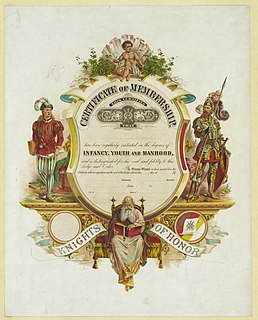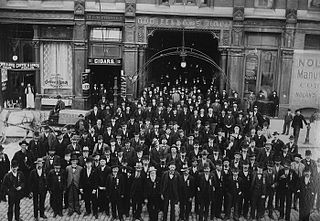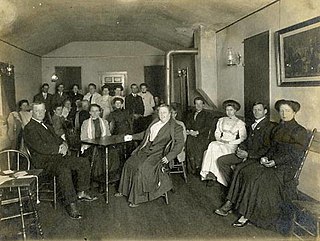Related Research Articles

The Improved Order of Red Men is a fraternal organization established in North America in 1834. Their rituals and regalia are modeled after those assumed by men of the era to be used by Native Americans. Despite the name, the order was formed solely by, and for, white men. The organization claimed a membership of about half a million in 1935, but has declined to a little more than 15,000.
The Knights of the Golden Eagle was a fraternal organization founded in Baltimore in 1872.

Knights of the Maccabees was a fraternal organization formed in 1878 in London, Ontario, Canada. Most active in the U.S. state of Michigan, the group's fraternal aspects took a backseat to providing low-cost insurance to members. In the society's early years it also provided other final-expense related benefits such as society cemeteries.

The Knights of Honor, was a fraternal order and secret society in the United States in the late 19th and early 20th century. The Knights were one of the most successful fraternal beneficiary societies of its time.

The Templars of Honor and Temperance established in the United States in 1845 as the Marshall Temperance Fraternity as part of the temperance movement. The Templars were formed as a result of a schism within the older Sons of Temperance, when some felt that the organization did not have an elaborated enough ritual. The new group changed its name several times, first to "Marshall Temple, No. 1, Sons of Honor", then to "Marshall Temple of Honor, No. 1, Sons of Temperance". In 1846, the National Temple of the Templars of Honor and Temperance of the United States was instituted in New York.
Fraternal Order Orioles is a social and charitable organization that was founded in August 1910. The organization currently consists of about 54 local Nests and affiliated Auxiliaries located in 9 States in the eastern United States.
The Improved Order of Heptasophs was a fraternal order in the United States that existed from 1878-1917. It was distinguished from its parent organization, the Order of Heptasophs in that its main focus was on insurance.

Catholic Financial Life (CFL) is a Milwaukee-based life insurer and fraternal organization. It is one of the largest Catholic not-for-profit financial services organizations in the United States, second only to the Knights of Columbus. Fraternal benefits societies are nonprofit membership organizations that designate a portion of their income for charity.

The Ancient Order of United Workmen (AOUW) was a fraternal organization in the United States and Canada, providing mutual social and financial support after the American Civil War. It was the first of the "fraternal benefit societies", organizations that would offer insurance as well as sickness, accident, death and burial policies.

The Supreme Council of the Royal Arcanum, commonly known simply as the Royal Arcanum, is a fraternal benefit society founded in 1877 in Boston, Massachusetts by John A. Cummings and Darius Wilson, who had previously been among the founders of the Knights of Honor, a similar organization, in Kentucky. The Royal Arcanum home office is located in Boston, Massachusetts.
The Gleaner Life Insurance Society, originally the Ancient Order of Gleaners, is a fraternal benefit society based in Adrian, Michigan.
The American Fraternal Alliance (AFA) is an umbrella group of fraternal orders in the United States. It was founded as the National Fraternal Congress of America in 1913, in Chicago and adopted its current name in 2011.
The Degree of Honor Protective Association is a fraternal benefit society. It was originally organized as a female auxiliary to the Ancient Order of United Workmen, but split off in 1910 to become its own independent group. It merged with Catholic Financial Life in 2017.
The American Legion of Honor was a fraternal benefit order that was active in the late 19th century and early 20th century. In its heyday, it was one of the best known benefit societies.
The Knights and Ladies of Honor was a highly successful and popular American fraternal benefit organization in the late 19th and early twentieth century. It is perhaps the first major fraternal benefit organization to adopt the idea of diversity allowing non-white persons and racial groups to be recognized and establish lodges.
The National Fraternal Society of the Deaf was an organization of deaf people in the United States and Canada modeled on ethnic fraternal orders that were popular at the beginning of the twentieth century.

The Ladies of the Maccabees (L.O.T.M.) was the female auxiliary of the Knights of the Maccabees. It was the first fraternal benefit society operated exclusively by women. This was an insurance benefit society which grew to 80,000 members by 1913 and had paid out over $50 million in endowment benefits. The Ladies of the Maccabees Building, in Port Huron, Michigan was listed on the National Register of Historic Places in 1982.
References
- ↑ Schmidt, Alvin J. Fraternal Organizations Westport, CT; Greenwood Press pp.190-1
- ↑ Schmidt p.191
- ↑ Stevens, Albert Clark, 1854- The Cyclopædia of Fraternities: A Compilation of Existing Authentic Information and the Results of Original Investigation as to More than Six Hundred Secret Societies in the United States (New York: Hamilton Printing and Publishing Company), 1899, p.126
- ↑ Schmidt p.191
- ↑ Stevens p.126
- ↑ Schmidt p.191